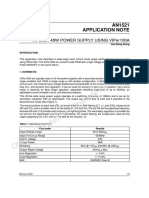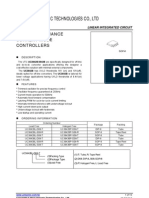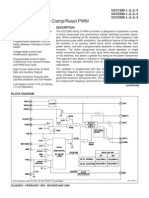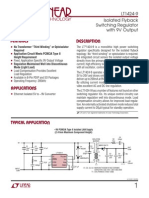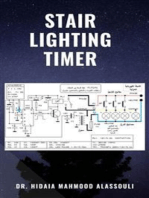At 30 Ic
At 30 Ic
Uploaded by
Cristina AntohiCopyright:
Available Formats
At 30 Ic
At 30 Ic
Uploaded by
Cristina AntohiOriginal Title
Copyright
Available Formats
Share this document
Did you find this document useful?
Is this content inappropriate?
Copyright:
Available Formats
At 30 Ic
At 30 Ic
Uploaded by
Cristina AntohiCopyright:
Available Formats
%
Page 1 of 9
AT30
High Performance Off-line Controller
Description
The AT30 is a high performance green-energy offline power supply controller. It features a scalable driver for driving external NPN or MOSFET transistors for line voltage switching. This proprietary architecture enables many advanced features to be integrated into a small package (TO-92 or SOT23-5), resulting in lowest total cost solution. The AT30 design has 6 internal terminals and is a pulse frequency and width modulation IC with many flexible packaging options. One combination of internal terminals is packaged in the space-saving TO-92 package (A/B/C/D versions) for 65kHz or 100kHz switching frequency and with 400mA or 800mA current limit. The E version (SOT23-5) can be configured for higher current limit. Consuming only 0.15W in standby, the IC features over-current, hiccup mode short circuit, and under-voltage protection mechanisms. The AT30 is ideal for use in high performance universal adaptors and chargers.
Features
High Performance with 0.15W Standby Power Current Mode Operation PWM/Pulse-Skipping Switching Control Emitter Drive Allows Safe NPN Flyback Use 65kHz or 100kHz Switching Frequency Leading Edge Blanking Complete Protection Circuits including Over-Current Protection, Under-Voltage Protection and Hiccup Mode for Short Circuit Flexible Packaging Options(including TO-92) Selectable 0.4A to 1.2A Current Limit Lowest Total Cost Solution
HIGH VOLTAGE DC
R1
D2
Q1
R2
Applications
IC1
Offline PWM AC/DC converter for Battery Charger Power Adaptor Universal Off-line Power Supplies Standby Power Supplies
C1 D1
DRV
AT30
GND
VDD
OPTOCOUPLER
Figure1. Simplified Application Circuit of AT30
http://www.sirectsemi.com/atc FP5101
http://dc205.4shared.com/doc/0nbIa9vj/preview.html
2012-04-22
Page 2 of 9
AT30
Ordering Information
Part Number AT30A AT30B AT30C AT30D AT30E Switching Frequency 65kHz 65kHz 100kHz 100kHz Selectable Current Limit 400mA 800mA 400mA 800mA Adjustable Temperature Range -40C to 85C -40C to 85C -40C to 85C -40C to 85C -40C to 85C Package To-92 To-92 To-92 To-92 SOT23-5 Pins 3 3 3 3 5
Pin Assignments
TO-92 SOT23-5
AT30A AT30B AT30C AT30D AT30E
Functional Pin Description
Pin Number TO-92 SOT23-5 PIN NAME Pin Function
1 2
1 2
VDD GND
Power Supply Pin. Connect to optocoupler's emitter. Internally limited to 5.5V max. Bypass to GND with a proper compensation network. Ground Driver Output (TO-92 Only). Connect to emitter of the high voltage NPN or MOSFET. For AT30A/C, DRV pin is internally connected to DRV1. For AT30B/D, DRV pin is internally connected to both DRV1 and DRV2. Driver Output 1 (SOT23-5 Only). Also used as supply input during startup. Driver Output 2 (SOT23-5 Only) Frequency Select (SOT23-5 Only). This terminal has an internal 200k pull down resistor. Connect to VDD for 100kHz operation. Connect to GND or leave unconnected for 65kHz operation.
DRV
5 4
DRV1 DRV2
FREQ
http://www.sirectsemi.com/atc FP5101
http://dc205.4shared.com/doc/0nbIa9vj/preview.html
2012-04-22
Page 3 of 9
AT30 Thermal Information
Junction Temperature------------------------- -40C to +150C Storage Temperature Range---------------- -55C to +150C Lead Temperature (Soldering, 10sec) ------------------300C
Absolute Maximum Ratings
VDD,FREQ Voltage------------------------------ -0.3V to + 6V VDD current---------------------------------------------------20mA VDRV, DRV1, DRV2 Voltage ---------------- -0.3V to + 18V Continuous DRV, DRV1, DRV2 Current--------------------Maximum Power Dissipation -------Internally limited 0.6W for TO-92 0.39W for SOT23-5
ESD Classification
Human Body Model-----------------------------------2000V Machine Model-------------------------------------------200V
Note Stresses beyond those listed under Absolute Maximum Ratings" may cause permanent damage to the device.
Electrical Characteristics
(TA = 25C, VDD=4V if not otherwise noted)
Parameter VDD Start Voltage V DD Clamp Voltage Supply Current Startup Supply Current VDD Under-Voltage Threshold Symbol V START VDD_CLP I DD IDDST U UV V DD = 4V before V Falling edge DRV1 must be DRV1 Start Voltage VDRVST higher than this AT30B/D voltage to start up. DRV1 Short-Circuit Detect Threshold V DRVSC AT30A/C AT30A/B or FREQ = 0 Switching frequency F SW AT30C/D or FREQ = V Maximum Duty Cycle Minimum Duty Cycle D MAX D MIN V DD =4V V DD =4.6V AT30A/C Effective Current Limit ILIM VDD =V UV +0.1V AT30B/D V DD to DRV1 Current Coefficient VDD Dynamic Impedance DRV1/DRV2 Driver On-Resistance DRV1 Rise Time DRV1 Fall Time DRV1 and DRV2 Switch Off Current G GAIN R VDD R DRV1, 2 I DRV1 = I DRV2 = 0.05A 1nF load, 15 pull-up 1nF load, 15 pull-up Driver off, V
DRV1 DD UV
Test Conditions Rising edge I(V DD )=10mA
Min 4.75
Typ 5
Max Units 5.25 V V 0.1 mA mA V 10.5 V 11.5 V 85 kHz 125 83 % %
5.15 5.45 5.75 0.7 0.23 0.45 3.17 3.35 3.53 AT30A/C 8.6 9.6 6.8 55 75 67 65 100 75 3.5 400
mA 800 -0.29 9 3.6 30 20 = 10V 12 30 A/V k ns ns A
=V
DRV2
http://www.sirectsemi.com/atc FP5101
http://dc205.4shared.com/doc/0nbIa9vj/preview.html
2012-04-22
Page 4 of 9
AT30
N-channel MOSFET. This emitter-drive method
Operation Description
Figure 2 shows the Functional Block Diagram of the AT30. The main components include switching
takes advantage of the high V
CBO
of the transistor,
CBO
allowing a low cost transistor such as 13003 (V = 700V) or 13002 (V control logic, two on-chip medium-voltage coupled with the turn-off characteristics of an power-MOSFETs with parallel current sensor, driver, external NPN result in lower EMI. oscillator and ramp generator, current limit VC The driver peak current is designed to have a generator, error comparator, hiccup control, bias and negative voltage coefficient with respect to supply undervoltage-lockout, and regulator circuitry. voltage V As seen in Figure 2, the design has 6 internal automatically results in higher DRV1 peak current. terminals. V
DD DD CBO
= 600V) to be used for a
wide AC input range. The slew-rate limited driver
, so that lower supply voltage
is the power supply terminal. DRV1 This way, the optocoupler can control V
DD
directly
and DRV2 are linear driver outputs that can drive the to affect driver current. emitter of an external high voltage NPN transistor or
DRV1 VDD BIAS & UVLO REGULATOR
DRV2
9k
3.6V(AT30A/C) 4.6V(AT30B/D) HICCUP CONTROL PWM/PULSE -SKIPPING SWITCHING CONTROL LOGIC SLEW 1x 56x 56x
FREQ
200k
OSC & RAMP CURRENT
20k
ILIM VC GENERATOR -
ERROR COMP
+ 40
20k
4.75V
GND
GND
Figure 2. Block Diagram of AT30
http://www.sirectsemi.com/atc FP5101
http://dc205.4shared.com/doc/0nbIa9vj/preview.html
2012-04-22
Page 5 of 9
AT30 Normal Operation
In normal operation, the feedback signal from the secondary side is transmitted through the optocoupler as a current signal into VDD pin, which has dynamic impedance of 9k
DRV1
Startup Sequence
Figure 1 shows a Simplified Application Circuit for the AT30. Initially, the small current through resistor R1 charges up the capacitor C1, and the BJT acts as a follower to bring up the DRV1 voltage. An internal regulator generates a V 3.6V for AT30A/C (V limits it to 5.5V max. As V
DRV1 DD
The resulting V
DD
voltage equal to V
voltage affects the switching of the IC. As seen from the Functional Block Diagram, the Current Limit VC Generator uses the V
DD
4.6V for AT30B/D) but
DD
crosses 5V, the
DD
voltage difference with
regulator sourcing function stops and V drop due to its current consumption. As V
begins to
DD
4.75V to generate a proportional offset at the negative input of the Error Comparator. The drivers turn on at the beginning of each switching cycle. The current sense resistor current, which is a fraction of the transformer primary current, increases with time as the primary current increases. When the voltage across this current sense resistor plus the oscillator ramp signal equals Error Comparator's negative input voltage, the drivers turn off. Thus, the peak DRV1 current has a negative voltage coefficient of -0.29A/V and can be calculated from the following: IDRV1PEAK for V
DD
voltage
decreases below 4.75V, the IC starts to operate with increasing driver current. When the output voltage reaches regulation point, the optocoupler feedback circuit stops V
DD
from decreasing further. The
switching action also allows the auxiliary windings to take over in supplying the C1 capacitor. Figure 3 shows a typical startup sequence for the AT30. To limit the auxiliary voltage, use a 12V zener diode for AT30A/C or a 13V zener for AT30B/D (D1 diode in Figure 1). Even though up to 2M startup resistor (R1) can be used due to the very low startup current, the actual R1 value should be chosen as a compromise between standby power and startup time delay.
= 0.29A/V (4.75V V < 4.75V and duty cycle < 50%.
DD
When the output voltage is lower than regulation,
Figure 3. Startup Waveforms
http://www.sirectsemi.com/atc FP5101
http://dc205.4shared.com/doc/0nbIa9vj/preview.html
2012-04-22
Page 6 of 9
AT30
each switching cycle (with minimum on time of 500ns) to the output causes VDD to increase slightly above 4.75V. The PWM Switching Control Logic block is able to detect this condition and prevents the IC from switching until V
DD
the current into VDD pin is zero and VDD voltage decreases. At V
DD
=V
UV
= 3.3V, the peak DRV1
current has maximum value of 400mA.
Current Limit Adjustment
The IC's proprietary driver arrangement allows the current limit to be easily adjusted between 400mA and 1.2A. To understand this, the drivers have to be utilized as linear resistive devices with typically 3.6 (rather than as digital output switches). The current limit can then be calculated through linear combination as shown in Figure 4. For TO-92 package, the AT30A/C are preprogrammed to 400mA current limit and the AT30B/D are preprogrammed to 800mA current limit. For AT30E (SOT23-5) packages, both DRV1 and DRV2 terminals are provided.
is below
4.75V again. This results in a pulse-skipping action with fixed pulse width and varying frequency, and low power consumption because the switching frequency is reduced. Typical system standby power consumption is 0.15W.
Short Circuit Hiccup
When the output is short circuited, the AT30 enters hiccup mode operation. In this condition, the auxiliary supply voltage collapses. An on-chip detector compares DRV1 voltage during the off-time of each cycle to 6.8V. If DRV1 voltage is below 6.8V, the IC will not start the next cycle,
DRV1
I LIM
400 mA
causing both the auxiliary supply voltage and V reduce further. The circuit enters startup mode when V
DD
DD
to
DRV2
drops below 3.3V. This hiccup behavior
DRV1
DRV2 RD
I LIM
400 mA
7 .2 R D 3.6 R D
continues until the short circuit is removed. In this behavior, the effective duty cycle is very low resulting in very low short circuit current.
DRV1
To make sure that the IC enters hiccup mode
DRV2
I LIM
800 mA
easily, the transformer should be constructed so that there is close coupling between secondary and
RD DRV1
I LIM
DRV2
400 mA
RD 3. 6
auxiliary, so that the auxiliary voltage is low when
the output is short-circuited. This can be achieved with the primary/auxiliary/secondary sequencing
Figure 4. Driver Output Configurations
from the bobbin.
Pulse Skipping
The PWM/Pulse Skipping Switching Control Logic block operates in different modes depending on the output load current level. At light load, the VDD voltage is around 4.75V. The energy delivered by
http://www.sirectsemi.com/atc FP5101
http://dc205.4shared.com/doc/0nbIa9vj/preview.html
2012-04-22
Page 7 of 9
AT30 Layout Considerations
The following should be observed when doing layout for the AT30: 1. Use a "star point" connection at the GND pin of AT30 for the VDD bypass components (C5 and C6
OUTCV
Application Example
The application circuit in Figure 6 provides a 5V/0.75A constant voltage/constant current output. An AT30 is used in combination with the TL431 for highest efficiency and lowest component count. To change the constant output voltage V constant current limit I following: R7 = 80k
[(V
OUTCV OUTCC
and
in Figure 6), the input filter capacitor (C2 in Figure 6) and other ground connections on the primary side.
, modify R7 and R6 as
-1V)/3.8V - 1]
2. Keep the loop across the input filter capacitor, the transformer primary windings, and the high voltage transistor, and the AT30 as small as possible. 3. Keep AT30 pins and the high voltage transistor 220VAC 0.15W 0.75A 67% pins as short as possible. 4. Keep the loop across the secondary windings, the output diode, and the output capacitors as small as possible. 5. Allow enough copper area under the high voltage transistor, output diode, and current shunt resistor for heat sink.
R6 = 250mV/I
OUTCC
The performance of this circuit is summarized in Table 1.
Table 1. System Performance of Circuit in Figure 6
110VAC Standby Power Current Limit Full Load Efficiency 0.09W 0.75A 65%
RF1 AC1 10 2W 85~265VAC T1 SR260 D1 D6 7uH LF2 5V/0.75A OUTPUT+
AC2
R2 1M
R4 100K 0.5W
C4 1000PF 1KV D2
FR107 D3 R3 C7 470uF 10V Q1 + C8 680uF 16V IN4148 R3 330 IC2
IN4148 C1 4.7uF 400V C2 4.7uF 400V D4
510 0.5W
C3 22uF 25V R6 R7 13K 3 PC817 IC3 47K C6 10nF
R1 R5 2.2K LF1 820uH D5 1N5242B 12V + 200 C5 10uF 6V
AT30A
2 C6
TL431
R8 12K
10nF
OUTPUT-
Figure 6. A 3.75W Charger Using AT30 in combination with TL431
http://www.sirectsemi.com/atc FP5101
http://dc205.4shared.com/doc/0nbIa9vj/preview.html
2012-04-22
Page 8 of 9
AT30
Outline Information
SYMBOL
DIMENSION IN MILIMETERS MIN MAX 3.700 1.400 0.550 0.510 4.700
DIMENSION IN INCHES MIN 0.130 0.043 0.015 0.014 0.173 0.135 MAX 0.146 0.055 0.022 0.020
SYMBOL
DIMENSION IN MILIMETERS MIN MAX 1.0 2.8 21 16.5
DIMENSION IN INCHES MIN -0.039 0.087 0.748 0.610 0.0098 MAX 0.039 0.110 0.827 0.650
A A1 b c D D1 E e e1 h
3.300 1.100 0.380 0.360 4.400 3.430 4.300
k F1,F2 H H0 L1
-1.0 2.2 19 15.5 2.5 12.4 -1.0 12.5 3.55 6.05 3.8 0.35 0.15 17.5 5.5 8.5
0.185
P P
13.0 1.0 12.9 4.15 6.65 4.2 0.45 0.25 19 6.5 9.5 1.0
0.488 -0.039 0.492 0.140 0.238 0.150 0.014 0.006 0.689 0.217 0.335
0.512 0.039 0.508 0.163 0.262 0.165 0.018 0.010 0.748 0.256 0.374 0.039
4.700
0.169
0.185
P0 P1 P2 Q1 t1
1.270TYP 2.440 2.640 1.600 0.000 0.380
0.050TYP 0.096 0.104 0.063 0.000 0.015
t2 W W0 W1 W2
http://www.sirectsemi.com/atc FP5101
http://dc205.4shared.com/doc/0nbIa9vj/preview.html
2012-04-22
Page 9 of 9
AT30
SYMBOL
DIMENSION IN MILIMETERS MIN MAX 1.250 0.100 1.150 0.400 0.200 3.020 1.700 2.950
DIMENSION IN INCHES MIN 0.041 0.000 0.041 0.012 0.004 0.111 0.059 0.104 MAX 0.049 0.004 0.045 0.016 0.008 0.119 0.067 0.116
A A1 A2 b c D E E1 e e1 L L1
1.050 0.000 1.050 0.300 0.100 2.820 1.500 2.650
0.950TYP 1.800 2.000
0.067TYP 0.071 0.079
0.700REF 0.300 0
0
0.028REF 0.012 0
0
0.600 8
0
0.024 8
0
-End of Specifications-
U.S.A.: atc@sirectsemi.com
China:
hhc@szatc.com.cn
http://www.sirectsemi.com/atc
9
FP5101
Amaxtronics Technology Corp.
http://dc205.4shared.com/doc/0nbIa9vj/preview.html
2012-04-22
You might also like
- MCAS - Some Potential MCAS Triggers Incl Hidden SulphitesNo ratings yetMCAS - Some Potential MCAS Triggers Incl Hidden Sulphites1 page
- Obsolete Product(s) - Obsolete Product(s) Obsolete Product(s) - Obsolete Product(s)No ratings yetObsolete Product(s) - Obsolete Product(s) Obsolete Product(s) - Obsolete Product(s)15 pages
- Transformer Driver For Isolated Power Supplies: Features ApplicationsNo ratings yetTransformer Driver For Isolated Power Supplies: Features Applications29 pages
- Forward Design 300W STmicroelectronics App NoteNo ratings yetForward Design 300W STmicroelectronics App Note10 pages
- ACS102-5Tx: Ac Line Switch Asd™ AC Switch FamilyNo ratings yetACS102-5Tx: Ac Line Switch Asd™ AC Switch Family8 pages
- Ncl30160 1.0A Constant-Current Buck Regulator For Driving High Power LedsNo ratings yetNcl30160 1.0A Constant-Current Buck Regulator For Driving High Power Leds10 pages
- Green-Mode PWM Controller: General Description FeaturesNo ratings yetGreen-Mode PWM Controller: General Description Features10 pages
- Single Ended Active Clamp/Reset PWM: Features DescriptionNo ratings yetSingle Ended Active Clamp/Reset PWM: Features Description16 pages
- MC34063A, MC33063A, NCV33063A 1.5 A, Step Up/Down/ Inverting Switching RegulatorsNo ratings yetMC34063A, MC33063A, NCV33063A 1.5 A, Step Up/Down/ Inverting Switching Regulators14 pages
- Isolated Flyback Switching Regulator W - 9V OutputNo ratings yetIsolated Flyback Switching Regulator W - 9V Output16 pages
- MC1488 Quad Line EIA 232D Driver: 10 Ma Typical MinimumNo ratings yetMC1488 Quad Line EIA 232D Driver: 10 Ma Typical Minimum10 pages
- Applications of Non Zero Crossing Triac Drivers MOC3011No ratings yetApplications of Non Zero Crossing Triac Drivers MOC30116 pages
- Reference Guide To Useful Electronic Circuits And Circuit Design Techniques - Part 2From EverandReference Guide To Useful Electronic Circuits And Circuit Design Techniques - Part 2No ratings yet
- Reference Guide To Useful Electronic Circuits And Circuit Design Techniques - Part 1From EverandReference Guide To Useful Electronic Circuits And Circuit Design Techniques - Part 12.5/5 (3)
- Design of Electrical Circuits using Engineering Software ToolsFrom EverandDesign of Electrical Circuits using Engineering Software ToolsNo ratings yet
- Influence of System Parameters Using Fuse Protection of Regenerative DC DrivesFrom EverandInfluence of System Parameters Using Fuse Protection of Regenerative DC DrivesNo ratings yet
- BA4022710-01 - MTeC EPT303 WiringDiagrammNo ratings yetBA4022710-01 - MTeC EPT303 WiringDiagramm1 page
- Bonding Compounds For Interior Gypsum PlasteringNo ratings yetBonding Compounds For Interior Gypsum Plastering5 pages
- 7th Gen Core Family Mobile U y Processor Lines Datasheet Vol 1No ratings yet7th Gen Core Family Mobile U y Processor Lines Datasheet Vol 1214 pages
- Microbiology Chapter 17 Tortora Flashcards - QuizletNo ratings yetMicrobiology Chapter 17 Tortora Flashcards - Quizlet4 pages
- FERC, NERC, and Regional Reliability CouncilsNo ratings yetFERC, NERC, and Regional Reliability Councils8 pages
- Operating Room Nursing: S Y 2018-2019 FIRST SEMNo ratings yetOperating Room Nursing: S Y 2018-2019 FIRST SEM29 pages
- Angue - FINAL OUTPUT - EMERGENCY PROCEDURESNo ratings yetAngue - FINAL OUTPUT - EMERGENCY PROCEDURES9 pages
- Calculation and Analysis of IGBT Power Loss in Drive System For EVNo ratings yetCalculation and Analysis of IGBT Power Loss in Drive System For EV2 pages
- Experiment No 4 Part A: Handover MechanismNo ratings yetExperiment No 4 Part A: Handover Mechanism8 pages
- Land Suitability Analysis Using Multi Attribute deNo ratings yetLand Suitability Analysis Using Multi Attribute de6 pages
- IGCSE Math 0580 Similarity Volume and Area Past Papers Worksheet P2No ratings yetIGCSE Math 0580 Similarity Volume and Area Past Papers Worksheet P29 pages
- Internal Remotely Electric Tilt (iRET) : Operation InstructionNo ratings yetInternal Remotely Electric Tilt (iRET) : Operation Instruction10 pages
- FNN-Guideline Energy Storage Version2019 EN PreviewNo ratings yetFNN-Guideline Energy Storage Version2019 EN Preview4 pages
- MCAS - Some Potential MCAS Triggers Incl Hidden SulphitesMCAS - Some Potential MCAS Triggers Incl Hidden Sulphites
- Obsolete Product(s) - Obsolete Product(s) Obsolete Product(s) - Obsolete Product(s)Obsolete Product(s) - Obsolete Product(s) Obsolete Product(s) - Obsolete Product(s)
- Transformer Driver For Isolated Power Supplies: Features ApplicationsTransformer Driver For Isolated Power Supplies: Features Applications
- Ncl30160 1.0A Constant-Current Buck Regulator For Driving High Power LedsNcl30160 1.0A Constant-Current Buck Regulator For Driving High Power Leds
- Green-Mode PWM Controller: General Description FeaturesGreen-Mode PWM Controller: General Description Features
- Single Ended Active Clamp/Reset PWM: Features DescriptionSingle Ended Active Clamp/Reset PWM: Features Description
- MC34063A, MC33063A, NCV33063A 1.5 A, Step Up/Down/ Inverting Switching RegulatorsMC34063A, MC33063A, NCV33063A 1.5 A, Step Up/Down/ Inverting Switching Regulators
- Isolated Flyback Switching Regulator W - 9V OutputIsolated Flyback Switching Regulator W - 9V Output
- MC1488 Quad Line EIA 232D Driver: 10 Ma Typical MinimumMC1488 Quad Line EIA 232D Driver: 10 Ma Typical Minimum
- Applications of Non Zero Crossing Triac Drivers MOC3011Applications of Non Zero Crossing Triac Drivers MOC3011
- Reference Guide To Useful Electronic Circuits And Circuit Design Techniques - Part 2From EverandReference Guide To Useful Electronic Circuits And Circuit Design Techniques - Part 2
- Reference Guide To Useful Electronic Circuits And Circuit Design Techniques - Part 1From EverandReference Guide To Useful Electronic Circuits And Circuit Design Techniques - Part 1
- Analog Dialogue, Volume 45, Number 2: Analog Dialogue, #2From EverandAnalog Dialogue, Volume 45, Number 2: Analog Dialogue, #2
- Design of Electrical Circuits using Engineering Software ToolsFrom EverandDesign of Electrical Circuits using Engineering Software Tools
- Analog Dialogue, Volume 46, Number 3: Analog Dialogue, #7From EverandAnalog Dialogue, Volume 46, Number 3: Analog Dialogue, #7
- Analog Dialogue, Volume 48, Number 1: Analog Dialogue, #13From EverandAnalog Dialogue, Volume 48, Number 1: Analog Dialogue, #13
- Variable Speed AC Drives with Inverter Output FiltersFrom EverandVariable Speed AC Drives with Inverter Output Filters
- Influence of System Parameters Using Fuse Protection of Regenerative DC DrivesFrom EverandInfluence of System Parameters Using Fuse Protection of Regenerative DC Drives
- Analog Dialogue, Volume 45, Number 3: Analog Dialogue, #3From EverandAnalog Dialogue, Volume 45, Number 3: Analog Dialogue, #3
- 7th Gen Core Family Mobile U y Processor Lines Datasheet Vol 17th Gen Core Family Mobile U y Processor Lines Datasheet Vol 1
- Microbiology Chapter 17 Tortora Flashcards - QuizletMicrobiology Chapter 17 Tortora Flashcards - Quizlet
- Calculation and Analysis of IGBT Power Loss in Drive System For EVCalculation and Analysis of IGBT Power Loss in Drive System For EV
- Land Suitability Analysis Using Multi Attribute deLand Suitability Analysis Using Multi Attribute de
- IGCSE Math 0580 Similarity Volume and Area Past Papers Worksheet P2IGCSE Math 0580 Similarity Volume and Area Past Papers Worksheet P2
- Internal Remotely Electric Tilt (iRET) : Operation InstructionInternal Remotely Electric Tilt (iRET) : Operation Instruction
- FNN-Guideline Energy Storage Version2019 EN PreviewFNN-Guideline Energy Storage Version2019 EN Preview












